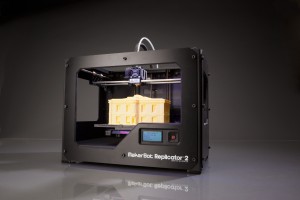Well, not really. But it might not be such a strange idea in the near future, as research into 3D printing continues to reveal incredible new uses for the technology.
3D-printing, professionally known as ‘additive manufacturing’ has already been around for a few decades, used to manufacture prototypes, or create cute desk ornaments and toys. Digital files contain the design of a model, and include instructions for the printer. Hundreds of different materials can be used, such as liquid plastics, powdered metals, nylon and ceramics. These materials are systematically hardened into a solid shape, with each successive layer forming a small part of the larger design.

Maker-Bot Replicator 2, one of the 3D printers widely available today on the market. Source: Flickr Commons user Creative Tools
We live in a world, however, where this kind of technology can do so much more than build ‘mini-me’ action figures. Imagine a natural disaster has just occurred in a remote location in the world, and only small aircrafts can reach the site. While it is still necessary to bring in medical professionals, some immediate aid can be provided in the form of 3D-printed casts, splints, and other medical supplies such as bandages and dressings. Syringe Extrusion, one method of additive technology, can use almost any liquid or paste to create a final product, meaning that one day we might even be able to 3D-print food, which would be particularly useful in situations like this one.
Now imagine an impoverished agricultural community, without the means to effectively sustain themselves. What can additive technology do for them? Machinery such as farm tractors, water pumps and tools for sustainable energy use (solar panels, wind turbines) can easily be printed and installed. This technology has the potential to increase the quality of life for many such communities, and the equipment would be cheaper than their mass-produced factory equivalents, due to the fact that 3D-printing eliminates the ‘assembly line’, so to speak. The power to create an object from widely available design software means that you won’t have the added costs associated with product development. Nor will you have any transportation costs, and this will also benefit the environment due to reduced CO2 emissions.
Arguably the most exciting use, though, is in the health industry. Researchers such as Ali Khademhosseini have been using this technology to ‘print’ natural sugar-based templates, on which to grow biological cells. These cells can then differentiate to grow different types of bodily tissue, including cardiac tissue and skin, which can be used in disease studies and drug therapy. For example, cancerous tumours have already been printed and reveal more about the specific proteins and characteristics of cancer than previous methods. Using these cells and tissues to test the effects of new drugs may also eliminate the controversial use of lab animals.

3D-printed ear and nose templates can be used to grow biological tissue. Source: Flickr Commons user UMHealthSystem
Transplant patients also benefit from 3D-printing; patients’ own cells are used to develop the needed tissues, thereby eliminating the risk of rejection of foreign transplants. Bone tissue is also being printed which may aid in the advancement of prosthetics, so who knows, maybe the title wasn’t so far off after all.
By Mikaela Stewart
